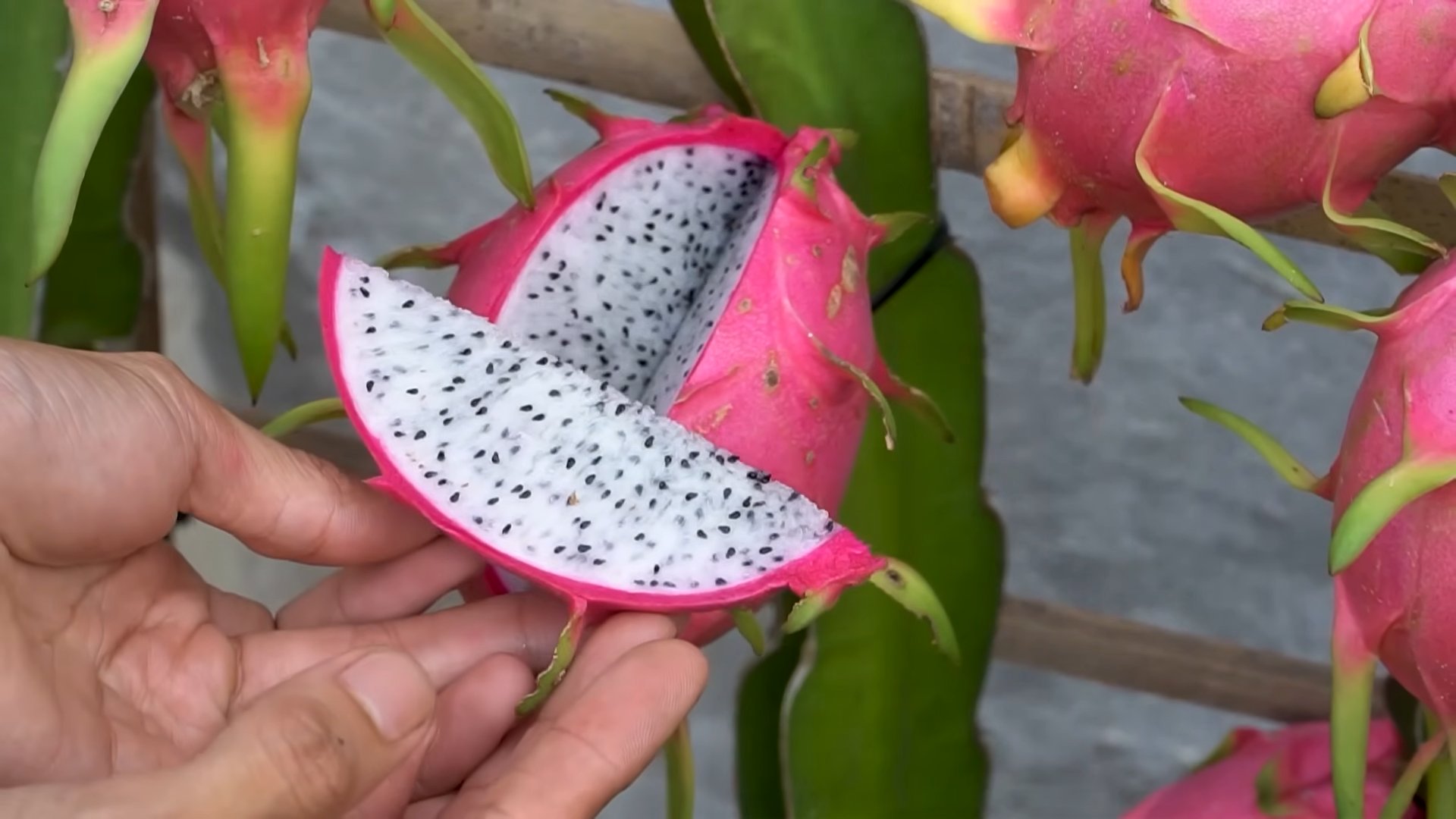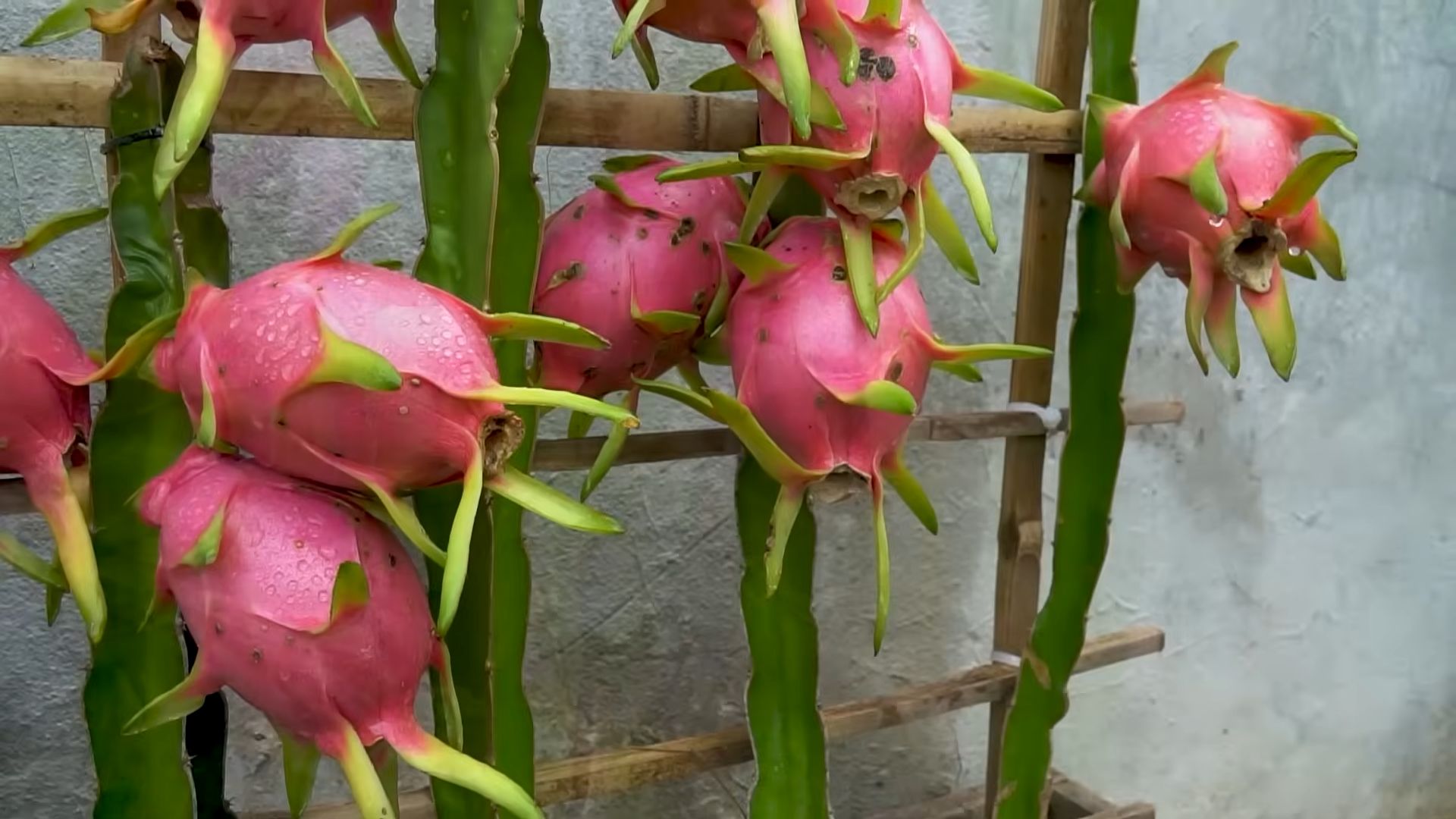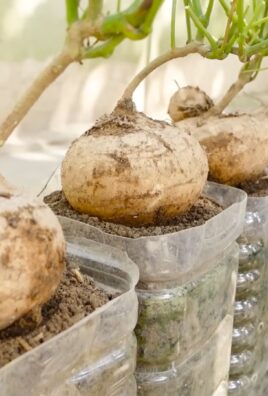Grow Dragon Fruit at Home? Absolutely! Imagine plucking a vibrant, exotic dragon fruit straight from your own backyard. Sounds like a tropical dream, right? Well, it’s more attainable than you think! This isn’t just about gardening; it’s about bringing a touch of the extraordinary into your everyday life.
Dragon fruit, also known as pitaya, has roots deeply embedded in Central and South American cultures, where it was cherished for its unique flavor and striking appearance. Today, it’s a global sensation, gracing supermarket shelves and inspiring culinary creations worldwide. But why settle for store-bought when you can cultivate your own?
I know what you might be thinking: “Dragon fruit? Isn’t that difficult to grow?” That’s where this DIY guide comes in! We’re breaking down the process into simple, manageable steps, revealing insider tricks and hacks that will have you harvesting your own delicious dragon fruit in no time. Whether you have a sprawling garden or just a sunny balcony, we’ll show you how to grow dragon fruit at home successfully.
Why do you need this DIY trick? Because fresh, homegrown dragon fruit tastes infinitely better than anything you can buy. Plus, it’s incredibly rewarding to nurture a plant from seedling to fruit-bearing beauty. So, grab your gardening gloves, and let’s embark on this exciting adventure together!

Grow Your Own Dragon Fruit: A Beginner’s Guide
Hey there, fellow plant enthusiasts! Ever dreamt of harvesting your own exotic dragon fruit right in your backyard (or even on your balcony)? Well, dream no more! I’m here to guide you through the surprisingly simple process of growing these vibrant, delicious fruits at home. Trust me, it’s easier than you think, and the reward is totally worth it.
Choosing Your Dragon Fruit Variety
Before we dive into the nitty-gritty, let’s talk about varieties. Dragon fruit, also known as pitaya, comes in several types, each with its own unique flavor and appearance. Here’s a quick rundown:
* **White-fleshed with pink skin:** This is the most common type you’ll find in grocery stores. It’s mildly sweet and refreshing.
* **Red-fleshed with pink skin:** These tend to be sweeter and juicier than the white-fleshed varieties.
* **Yellow-fleshed with white skin:** These are considered the sweetest and most flavorful of all dragon fruit.
When choosing a variety, consider your climate and taste preferences. Some varieties are more cold-hardy than others. Also, keep in mind that some dragon fruit varieties are self-pollinating, while others require cross-pollination (meaning you’ll need to plant two different varieties to get fruit). Do a little research to find the perfect fit for your needs. I personally started with a self-pollinating red-fleshed variety, and it’s been a breeze!
Getting Started: Propagation Methods
You have two main options for starting your dragon fruit journey: seeds or cuttings.
* **From Seeds:** Growing from seeds is a fun experiment, but it takes longer to get fruit (usually 5-7 years). Plus, the fruit might not be exactly like the parent plant.
* **From Cuttings:** This is the faster and more reliable method. You’ll get fruit much sooner (usually within 1-2 years), and the fruit will be identical to the parent plant. I highly recommend starting with cuttings for quicker results.
Propagating from Cuttings: My Preferred Method
This is how I started, and I can vouch for its effectiveness. Here’s what you’ll need:
* A healthy dragon fruit cutting (at least 12 inches long)
* A sharp, clean knife or pruning shears
* Rooting hormone (optional, but it helps!)
* A well-draining potting mix (cactus mix works great)
* A pot or container
**Step-by-Step Instructions:**
1. **Prepare the Cutting:** Using your sharp knife or pruning shears, make a clean cut at the base of the cutting. Let the cut end callous over for about a week. This helps prevent rot. I usually leave mine in a dry, shaded area.
2. **Apply Rooting Hormone (Optional):** Dip the cut end of the cutting into rooting hormone powder. This will encourage root development.
3. **Plant the Cutting:** Fill your pot with well-draining potting mix. Make a hole in the center and insert the cutting, burying about 2-3 inches of the base.
4. **Water Sparingly:** Water the cutting lightly, just enough to moisten the soil. Avoid overwatering, as this can lead to rot.
5. **Provide Support:** Dragon fruit are climbing cacti, so they’ll need support as they grow. You can use a stake, trellis, or even a sturdy post.
6. **Place in a Sunny Location:** Dragon fruit thrive in full sun (at least 6 hours of direct sunlight per day).
7. **Be Patient:** It can take several weeks or even months for the cutting to root. Keep the soil lightly moist and be patient. You’ll know it’s rooted when you see new growth.
Caring for Your Dragon Fruit Plant
Once your cutting has rooted and started to grow, it’s time to provide the proper care to ensure healthy growth and abundant fruit production.
Watering
Dragon fruit are drought-tolerant, but they still need regular watering, especially during the growing season (spring and summer). Water deeply when the top inch of soil feels dry. Avoid overwatering, as this can lead to root rot. In the winter, reduce watering frequency.
Fertilizing
Feed your dragon fruit plant with a balanced fertilizer (e.g., 10-10-10) every 1-2 months during the growing season. You can also use a fertilizer specifically formulated for cacti and succulents. I like to use a slow-release fertilizer in the spring to give my plants a good boost.
Pruning
Pruning is essential for maintaining the shape and size of your dragon fruit plant. It also encourages branching and fruit production. Prune away any dead, damaged, or crossing branches. You can also prune to control the overall size and shape of the plant. I usually prune mine in the late winter or early spring before new growth begins.
Support Structure
As your dragon fruit plant grows, it will need a strong support structure to climb on. A sturdy trellis, post, or even a tree can work well. Make sure the support is strong enough to handle the weight of the plant and its fruit. I use a concrete post with a circular trellis on top, which allows the branches to cascade down.
Pollination
Some dragon fruit varieties are self-pollinating, while others require cross-pollination. If you have a self-pollinating variety, you don’t need to worry about pollination. However, if you have a variety that requires cross-pollination, you’ll need to plant two different varieties and either rely on natural pollinators (like bees and moths) or hand-pollinate the flowers yourself.
**Hand-Pollination:**
This is easier than it sounds! Dragon fruit flowers bloom at night and only last for one night. To hand-pollinate, use a small brush to transfer pollen from the stamen (the male part of the flower) to the pistil (the female part of the flower). Do this as soon as the flower opens. I usually do it around midnight when the flowers are fully open.
Pest and Disease Control
Dragon fruit are generally pest and disease-resistant, but they can occasionally be affected by pests like aphids, mealybugs, and scale. You can control these pests with insecticidal soap or neem oil. Root rot is the most common disease, which is caused by overwatering. Prevent root rot by ensuring good drainage and avoiding overwatering.
Harvesting Your Dragon Fruit
The moment you’ve been waiting for! Dragon fruit typically ripen about 30-50 days after flowering. Here’s how to tell when your dragon fruit is ready to harvest:
* The skin will turn from green to bright pink or red (depending on the variety).
* The fruit will feel slightly soft to the touch.
* The “wings” or scales on the fruit will start to dry out and turn brown.
To harvest, simply twist the fruit off the plant. Be careful not to damage the plant. Enjoy your homegrown dragon fruit! I love eating mine fresh, but you can also use it in smoothies, salads, or desserts.
Troubleshooting
Even with the best care, you might encounter some challenges along the way. Here are a few common problems and how to fix them:
* **Yellowing Leaves:** This could be a sign of overwatering, underwatering, or nutrient deficiency. Adjust your watering schedule and fertilize as needed.
* **Lack of Fruit:** This could be due to a lack of pollination, insufficient sunlight, or improper fertilization. Make sure your plant is getting enough sunlight, fertilize regularly, and hand-pollinate if necessary.
* **Rotting Stem:** This is usually caused by overwatering. Allow the soil to dry out completely between waterings. If the rot is severe, you may need to cut off the affected area and replant the healthy portion.
Final Thoughts
Growing dragon fruit at home is a rewarding experience that anyone can enjoy. With a little patience and care, you’ll be harvesting your own delicious, exotic fruit in no time. So, go ahead and give it a try! I promise you won’t regret it. Happy growing!

Conclusion
So, there you have it! Growing dragon fruit at home might seem like an exotic endeavor reserved for seasoned gardeners, but with a little patience, the right setup, and this straightforward DIY trick, you can cultivate your own supply of this vibrant and delicious fruit. We’ve demystified the process, breaking it down into manageable steps that even beginners can follow.
Why is this DIY approach a must-try? Because it empowers you to control the entire growing process, from selecting the perfect cutting or seed to nurturing the plant to maturity. You’ll know exactly what goes into your dragon fruit, ensuring it’s free from harmful pesticides and grown with love. Plus, there’s an undeniable satisfaction in harvesting fruit you’ve personally cultivated. Imagine the bragging rights!
Beyond the basic method outlined, there’s plenty of room for experimentation. Consider these variations to personalize your dragon fruit growing journey:
* Vertical Gardening: If you’re short on space, explore vertical gardening techniques. Dragon fruit vines thrive when supported, so a trellis, fence, or even a repurposed ladder can become a stunning and productive feature in your garden.
* Different Varieties: Don’t limit yourself to just one type of dragon fruit! Experiment with different varieties, each boasting unique flavors and colors. Some popular choices include the white-fleshed varieties like ‘Hylocereus undatus’, the red-fleshed ‘Hylocereus costaricensis’, and the yellow-skinned ‘Selenicereus megalanthus’.
* Grafting: For faster fruiting and increased disease resistance, consider grafting your desired dragon fruit variety onto a more robust rootstock. This technique requires some skill, but the rewards can be significant.
* Hydroponics: For those who want to grow dragon fruit indoors or in a controlled environment, hydroponics can be a great option. This method involves growing plants without soil, using nutrient-rich water solutions.
Ultimately, the best way to learn is by doing. Don’t be afraid to get your hands dirty, experiment with different techniques, and adapt the process to suit your specific environment and preferences. The journey of growing dragon fruit at home is just as rewarding as the delicious fruit you’ll eventually harvest.
We’re confident that with this DIY trick, you’ll be well on your way to enjoying homegrown dragon fruit. Now, it’s your turn! Give it a try, document your progress, and share your experiences with us. We’d love to hear your tips, tricks, and any challenges you encounter along the way. Let’s build a community of dragon fruit enthusiasts and learn from each other’s successes (and occasional failures!). Share your photos and stories on social media using #HomegrownDragonFruit and let’s celebrate the joy of growing our own food. Happy growing!
Frequently Asked Questions (FAQ)
What is the best time of year to plant dragon fruit?
The ideal time to plant dragon fruit is during the late spring or early summer. This allows the plant to establish itself during the warm growing season and develop a strong root system before the cooler months arrive. In regions with mild winters, you can potentially plant dragon fruit year-round, but avoid planting during periods of extreme heat or cold.
How long does it take for dragon fruit to fruit after planting?
Dragon fruit plants typically take between 6 months to 2 years to begin producing fruit, depending on the variety, growing conditions, and whether you started from seed or a cutting. Plants grown from cuttings generally fruit sooner than those grown from seed. Providing optimal care, including adequate sunlight, well-draining soil, and regular fertilization, can help accelerate the fruiting process. Grafted plants can fruit even sooner, sometimes within the first year.
What kind of soil is best for growing dragon fruit?
Dragon fruit thrives in well-draining soil that is rich in organic matter. A slightly acidic to neutral pH (around 6.0 to 7.0) is ideal. Avoid heavy clay soils that retain too much water, as this can lead to root rot. Amend your soil with compost, perlite, or sand to improve drainage and aeration. A good soil mix for dragon fruit could include equal parts potting soil, compost, and perlite.
How much sunlight does dragon fruit need?
Dragon fruit plants need at least 6-8 hours of direct sunlight per day to thrive and produce fruit. While they can tolerate some shade, insufficient sunlight can result in poor growth, reduced flowering, and smaller, less flavorful fruit. If you’re growing dragon fruit indoors, supplement with grow lights to ensure they receive adequate light.
How often should I water my dragon fruit plant?
Water dragon fruit plants deeply but infrequently, allowing the soil to dry out slightly between waterings. Overwatering is a common mistake that can lead to root rot. During the growing season (spring and summer), water more frequently, especially during hot, dry weather. Reduce watering during the dormant season (fall and winter). Always check the soil moisture before watering to avoid overwatering.
What kind of fertilizer should I use for dragon fruit?
Dragon fruit plants benefit from regular fertilization, especially during the growing season. Use a balanced fertilizer with an NPK ratio of around 10-10-10 or 15-15-15. You can also supplement with organic fertilizers like compost tea or worm castings. Avoid over-fertilizing, as this can burn the roots. Apply fertilizer every 2-3 months during the growing season and reduce or eliminate fertilization during the dormant season.
How do I pollinate dragon fruit flowers?
Most dragon fruit varieties are self-pollinating, meaning they can pollinate themselves. However, cross-pollination with another variety can often result in larger and more flavorful fruit. Dragon fruit flowers bloom at night and are typically pollinated by bats and moths. If you’re growing dragon fruit indoors or in an area with limited pollinators, you may need to hand-pollinate the flowers. Use a small brush to transfer pollen from the stamen (male part) to the pistil (female part) of the flower.
How do I prune dragon fruit plants?
Pruning is essential for maintaining the shape and health of your dragon fruit plant. Prune regularly to remove dead, damaged, or overcrowded branches. Also, prune to encourage branching and fruiting. The best time to prune is after the fruiting season. Remove any branches that are growing downwards or crossing each other. Leave the main branches that are growing upwards and outwards.
What are some common pests and diseases that affect dragon fruit?
Dragon fruit plants can be susceptible to various pests and diseases, including aphids, mealybugs, scale insects, and fungal diseases like stem rot and root rot. Regularly inspect your plants for signs of infestation or disease. Treat infestations with insecticidal soap or neem oil. Prevent fungal diseases by ensuring good air circulation, avoiding overwatering, and using a fungicide if necessary.
Can I grow dragon fruit in a container?
Yes, dragon fruit can be successfully grown in containers, making it a great option for those with limited space. Choose a large container with good drainage holes. Use a well-draining potting mix and provide a sturdy trellis or support structure for the vines to climb. Container-grown dragon fruit may require more frequent watering and fertilization than those grown in the ground.
How do I know when my dragon fruit is ripe?
A ripe dragon fruit will have a vibrant, even color and will feel slightly soft to the touch. The “wings” or bracts on the fruit will start to dry out and turn brown. The fruit should also detach easily from the stem with a gentle twist. Taste is the ultimate test – a ripe dragon fruit will be sweet and juicy.
What is the best way to store dragon fruit?
Store ripe dragon fruit in the refrigerator for up to a week. You can also cut the fruit into pieces and freeze it for longer storage. Frozen dragon fruit is great for smoothies and other frozen desserts.
Is growing dragon fruit at home worth the effort?
Absolutely! While it requires some initial investment of time and effort, growing dragon fruit at home is a rewarding experience. You’ll have access to fresh, delicious, and pesticide-free fruit, and you’ll enjoy the satisfaction of nurturing a plant from seedling to harvest. Plus, dragon fruit plants are beautiful and can add a touch of the exotic to your garden or home.





Leave a Comment